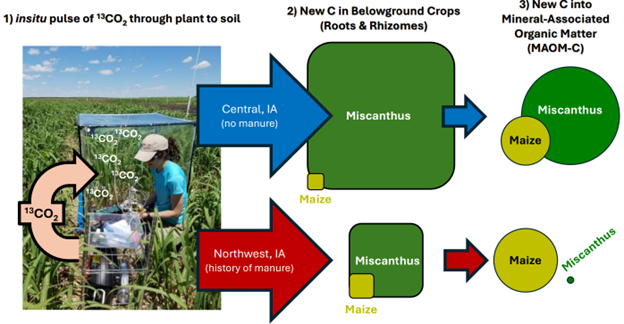Historical Land Management Alters New Soil Carbon Inputs by Annual and Perennial Bioenergy Crops
Themes: Feedstock Production, Sustainability
Keywords: Biomass Analytics, Carbon, Soil
Citation
Keiser, A.D., Heaton, E., VanLoocke, A., Studt, J., McDaniel, M. June 20, 2025. Data from: “Historical Land Management Alters New Soil Carbon Inputs by Annual and Perennial Bioenergy Crops.” Dryad. DOI: 10.5061/dryad.ns1rn8q4v.
Overview

Bioenergy and bioproduct markets are expanding to meet demand for climate friendly goods and services. Perennial biomass crops are particularly well suited for this goal because of their high yields, low input requirements, and potential to increase soil carbon (C). However, it is unclear how much C is allocated into belowground pools by perennial bioenergy crops and whether the belowground benefits vary with nitrogen (N) fertilizer inputs. Using in situ 13C pulse-chase labeling, we tested whether the sterile perennial grass Miscanthus × giganteus (miscanthus) or annual maize transfers more photosynthetic C to belowground pools. The experiment took place at two sites in Central and Northwest (NW) Iowa with different management histories and two nitrogen (N) fertilizer rates (0 and 224 kg N ha-1 yr-1) to determine if the fate of plant-derived soil C depends on soil fertility and crop type (perennial or annual). Maize allocated a greater percentage of total new 13C to roots than miscanthus, but miscanthus had greater new 13C in total and belowground plant biomass. We found strong interactions between site and most soil measurements – including new 13C in mineral and particulate soil organic matter (SOM) pools –which appear to be driven by differences in historical fertilizer management. The NW Iowa site, with a history of manure inputs, had greater plant-available nutrients (phosphorus, potassium, and ammonium) in soils, and resulted in less 13C from miscanthus in SOM pools compared to maize (approximately 64% less in POM and 70% less in MAOM). In more nutrient-limited soils (Central site), miscanthus transferred 4.5 times more 13C than maize to the more stable mineral-associated SOM pool. Our results suggest that past management, including historical manure inputs that affect a site’s soil fertility, can influence the net C benefits of bioenergy crops.
Data
Dryad: includes raw data (plant clippings, plant component data)
Illinois Data Bank: includes supplemental information, site climate management overview, and ancillary soil properties